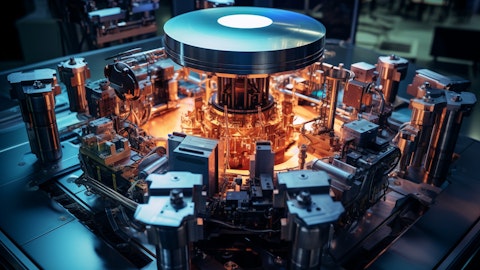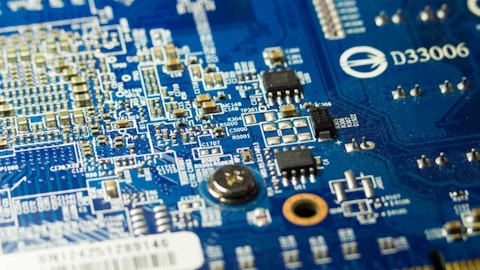Wei Mok: Okay, thank you.
Operator: Our next question comes from the line of Gus Richard with Northland Capital. Please proceed with your question.
Gus Richard: Yes, thanks for taking the questions. On your compound semi-business, can you give us a little bit of update on GaN power and sort of placements of EVALuation tools in that market?
Bill Miller: Yes, Gus. We’ve obviously, as you know, been working very hard in focusing our business in power electronics, namely GaN on silicon and silicon carbide. What we’ve been seeing is a transition from 6-inch to 8-inch over the last year and a half or so. But what we’re seeing is some customers are looking to leapfrog to 12-inch, particularly some of the Tier 1 silicon power electronics manufacturers are interested in introducing wide bandgap materials into their standard products. And so we actually are planning to ship a 300-millimeter EVALuation system to this customer in the coming quarter. So we’re excited about that form factor transition to 300-millimeter.
Gus Richard: Got it. And then your hard disk drive business has been kind of lagging. The drive business looks like it’s bottoming and starting to turn. Are you starting to see more activity there where your spares and services can kind of start to pick up in that market? Or is it just still looking flattish?
Bill Miller: I would characterize it, Gus, as clearly our customers have been running at very low utilizations, and clearly that’s been reading out in our service number in terms of spares and whatnot. I would say when we look at our data storage kind of run rate business, kind of weekly and monthly, it’s been running at very low levels here. And maybe we’ve seen a number of weeks, maybe a month or two of a bit of an uptick, but clearly nowhere near kind of the historical run rate. But maybe going in the right direction, I’d say.
Gus Richard: Got it. That’s helpful. Thanks. And then the last one for me is an ion beam depositions a couple quarters ago, you had a customer that was going to utilize it for EUV mask pellicles. And I was wondering if anything ever became of that if there was any interest in an additional system, any color there?
Bill Miller: Yes, we’re — they’re actually, I would say, pressuring us pretty hard to accelerate the shipment of that. That tool is going to ship here in the coming months. And we’re prepared to install it and fully support it at the customer. And assuming we have success, I wouldn’t be surprised that we have another follow-on order in a year or so.
Gus Richard: Got it. Okay. That’s it for me. Thanks so much.
Bill Miller: Thanks, Gus.
Operator: Our next question comes from the line of Dave Duley with Steelhead Securities. Please proceed with your question.
Dave Duley: Yes. Good afternoon. I was looking at one of the slides in your slide deck with the architecture of the high bandwidth memory next to the GPU die. And you talked about earlier to someone else’s question that you’re working on, I think, both the logic-based logic die and the high bandwidth memory stack itself. So I was kind of wondering, is that true you’re working on kind of two steps, both the individual high bandwidth memory and then the base logic die, if that’s the case? And then also, help us understand what sort of performance improvement the customer gets from using an LSA tool versus a flash annealing tool.
Bill Miller: I would say, just to be clear on that cartoon, I don’t have it right in front of me at the moment, but I would say the comment was not the GPU kind of left hand side of the picture, but it was really about the logic die underneath the stack.
Dave Duley: Correct.
Bill Miller: So we are qualified for that. And now, in the cartoon, you see four blue HBM DRAM die. There is actually peripheral logic on each of those four dies. So you can imagine the opportunity, and this is just a cartoon, would be multiplied by the amount of area of — times four for the HBM DRAM die. Does that answer your question?
Dave Duley: Yes, partially. And then as a follow-up, similar to in the foundry and logic space, where you’ve gone from one annealing step to two or three at a couple of these leading customers. I think there’s multiple annealing steps in this process as well. Do you think there is opportunity for you to repeat that performance you’ve seen in high-end foundry and logic, pick up more than one annealing step in the stack?
Bill Miller: It is possible. Today, we are qualified, my understanding is, for just one application step, but there are — there is potential opportunities and we actually are working with our customers’ R&D group to address that. And I would also say that, going back to your previous question on the performance, it’s very hard to attach the speed of the HBM device, but I can tell you that the customer does have very high-performance HBM. And I’m not sure it’s directly attributable to LSA, if I did, I would love to tell you but…
Dave Duley: Yes. Okay. And then, as far as, I’m assuming that you’re going to grow your HBM business with the current customer, would you expect to start to recognize revenue from the other customers? In other words, have the other customers started to — the interest levels started to increase where things are progressing with these other guys?
Bill Miller: Yes, Dave, we’ve been doing demos with the other two customers for some time, and we are really pushing to target an EVALuation system to that to a second customer by year-end or early 2025 at the latest. So that’s an internal goal that we have is to try to place that second memory EVAL system. And just like we did in logic, kind of win one customer, win one application, and then expand more applications and more customers. That’s definitely part of the plan.
Dave Duley: Okay, thank you.
Bill Miller: Thanks, Dave.
Operator: Our next question comes from the line of Mark Miller with the Benchmark Company. Please proceed with your question.
Mark Miller: Congratulations on your orders. Just wondering, what is your outlook for data storage this year? When do you feel that data storage will start feeling a growth from AI-type applications? Are we still a year away there?
John Kiernan: Yes, so thanks for the question, Mark. Maybe this is a combination of Bill and myself. I’ll start with our outlook for data storage for the year. So for the overall business, including our spare parts and service, we expect our data storage business, compared to last year, to be flat to up 10%. And we have good visibility into our systems and our systems backlog and confirm ship dates from the customer, et cetera. So I am pretty — I think that’s within a pretty tight range there. And I would say the upside to the range is if, as discussed on one of the earlier questions on the call here today, if the service business picks up a bit quicker than we’re forecasting.


